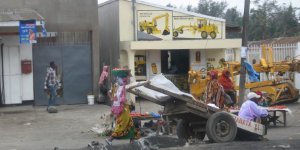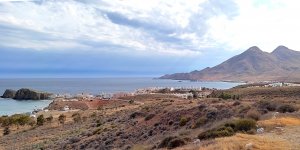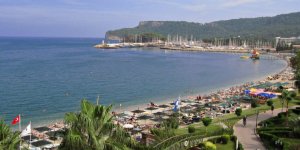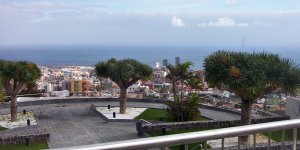| Published in Destinations |
At the Top of Africa…literally
CRISTINA ŞTEFAN, July 2005.
I couldn’t feel my feet anymore; the cold was piercing all my exposed skin, my mouth was as dry as the alpine desert I was surrounded by, and the shouts of the fellow trekkers had been drowned by the throbbing headache echoing in my ears.
I was in a state of daze from the headache and exhaustion, collapsed on a volcanic rock at Stella’s Point on the Kilimanjaro crater, the access point to Uhuru Peak (5896m). All I could think of was that I had to get off the mountain and start feeling somewhat normal again.

Uhuru Peak, highest in Africa
Four days before, the trek seemed like it would be a piece of cake. We had 6 porters, one guide, one assistant guide and a cook…all just for Alina, Nick and myself. We were all suited up: hiking boots, goretex pants, freezing proof water bottles and matching walking poles.
Our porters were sporting some knockoff sneakers and were dressed as they were about to take a walk through the park, and not the highest peak in Africa.
The first day we trekked 18 km through a smoky rain forest followed by another 9km trek on the second day mostly in a cloud that drove us to joke around that the guide was really taking us in circles around a hill, since in the 48 hours we spent on the mountain we had not once spotted the peak.
But when we reached Shira camp at the end of the second day and were above the clouds, we saw it was no joke and that neither the attempt to make it to the top would be. Uhuru Peak was up there, towering two thousand meters above our tents, two more days, fifty more kilometers worth of trail, and at least fifteen liters of drinking water away.
The next two days, the altitude effects were setting in and no matter how much water was passing through my system it was less and less effective against the excruciating headaches.
We reached the last camp, Barafu, on the fourth day around 4pm and I settled in my tent, drinking tea like it was medicine and watching as the clouds above the lower Kibo Peak, across from us, were changing colors.
I snoozed until 11 pm when our cook, Goodluck (no joke, that was his name) woke me up, put another cup of tea and biscuit in my hand and said “muzungu (wanderer) watch sunrise up Uhuru.” At least one of us thought I would make it to the top!
We started climbing at midnight, going so “pole-pole” (slowly, slowly) that I felt I was watching a video of myself in slow motion. Everything about our surroundings was so crisp that it seemed the sound of our walking poles against the pebbles might break something.
No clouds, an almost full moon, and a blanket of stars made our headlamps useless, and as we were trudging along through the lunar looking landscape I was concentrating on the two steps between the guide and myself trying to forget that there were really twelve kilometers worth of two steps left to the top.
Every step required more and more effort, more and more breaths. Little by little my feet gave in to the cold and eventually I couldn’t feel anything below my ankles. As I was wobbling along, I was trying to just mentally detach from everything around me, to lose track of time so maybe I wouldn’t realize when the top was within reach.
By 4am, Alina and Nick decided to turn back as she was getting dizzy and afraid she wouldn't be able to keep to the path. Around 6am, I finally reached Stella’s Point only a 20 minute hike from the peak and thus won myself an extended 10 minute break.
For every step I had to take three breaths and felt that I was losing more energy breathing than walking. The morning was growing behind us as we reached the top, adding to the dramatic effect of the glaciers on our left.
The 10 minutes I spent at the top were in a daze. I remember a glacier on the right side, the crater on the left, people screaming at others to take their pictures and just finally being surrounded by lots of light and warmth. I snapped a picture in each direction, literally, not even looking at what I was capturing and started walking, or better said wobbling, back down.
Eventually I started to feel my feet again and 2 hours later I was back in my tent, dreaming that I reached Uhuru.

View of Mount Meru1 from Shira Camp on Kilimanjaro

Uhuru Peak, and the proof I was at the top
Notes
1. Mount Meru (the namesake of the sacred mountain of Hindu, Jain, and Buddhist cosmology) is a dormant stratovolcano located 70 kilometres (43 mi) west of Mount Kilimanjaro in southeast Arusha Region, Tanzania. At a height of 4,562.13 metres (14,968 ft), it is visible from Mount Kilimanjaro on a clear day, and is the fifth-highest of the highest mountain peaks of Africa, dependent on definition.
Mount Meru is located just north of the city of Arusha, in the Arusha Region of Tanzania. It is the second-highest mountain in Tanzania, after Mount Kilimanjaro. Mount Meru is also the highest mountain/point in Arusha Region. The Momella route – which starts at Momella gate, on the eastern side of the mountain – is used to climb Mount Meru.
Much of its bulk was lost about 7,800 years ago due to a summit collapse. Mount Meru most recently had a minor eruption in 1910. The several small cones and craters seen in the vicinity probably reflect numerous episodes of volcanic activity. Mount Meru's caldera is 2.2 miles (3.5 km) wide.
Mount Meru is the topographic centerpiece of Arusha National Park. Its fertile slopes rise above the surrounding savanna and support a forest that hosts diverse wildlife, including nearly 400 species of birds, and also monkeys and leopards. The movie Hatari! was filmed at the foot of Mountain Meru. (Wikipedia)
YOU MAY ALSO LIKE





 If you own or manage a travel-related business such as a hotel, a bed-and-breakfast, a restaurant, a pub or a cafeteria, you can create a web page for your business for free on Titi Tudorancea Travel Info. » |
